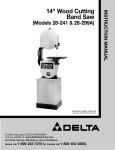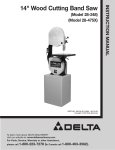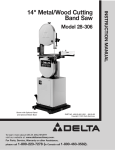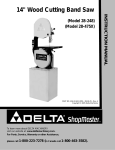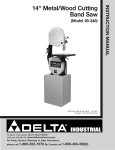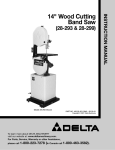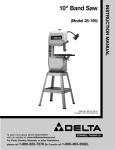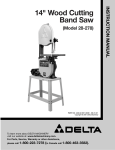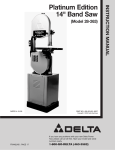Download Delta 28-206 Instruction manual
Transcript
(Models 28-206, 28-276) MODEL 28-206 SHOWN PART NO. 906452 - 08-16-02 Copyright © 2002 Delta Machinery To learn more about DELTA MACHINERY visit our website at: www.deltamachinery.com. For Parts, Service, Warranty or other Assistance, please call ESPAÑOL: PÁGINA 25 1-800-223-7278 (In Canada call 1-800-463-3582). INSTRUCTION MANUAL 14" Band Saws GENERAL SAFETY RULES Woodworking can be dangerous if safe and proper operating procedures are not followed. As with all machinery, there are certain hazards involved with the operation of the product. Using the machine with respect and caution will considerably lessen the possibility of personal injury. However, if normal safety precautions are overlooked or ignored, personal injury to the operator may result. Safety equipment such as guards, push sticks, hold-downs, featherboards, goggles, dust masks and hearing protection can reduce your potential for injury. But even the best guard won’t make up for poor judgment, carelessness or inattention. Always use common sense and exercise caution in the workshop. If a procedure feels dangerous, don’t try it. Figure out an alternative procedure that feels safer. REMEMBER: Your personal safety is your responsibility. This machine was designed for certain applications only. Delta Machinery strongly recommends that this machine not be modified and/or used for any application other than that for which it was designed. If you have any questions relative to a particular application, DO NOT use the machine until you have first contacted Delta to determine if it can or should be performed on the product. Technical Service Manager Delta Machinery 4825 Highway 45 North Jackson, TN 38305 (IN CANADA: 505 SOUTHGATE DRIVE, GUELPH, ONTARIO N1H 6M7) WARNING: FAILURE TO FOLLOW THESE RULES MAY RESULT IN SERIOUS PERSONAL INJURY 1. FOR YOUR OWN SAFETY, READ INSTRUCTION MANUAL BEFORE OPERATING THE TOOL. Learn the tool’s application and limitations as well as the specific hazards peculiar to it. 2. KEEP GUARDS IN PLACE and in working order. 3. ALWAYS WEAR EYE PROTECTION. Wear safety glasses. Everyday eyeglasses only have impact resistant lenses; they are not safety glasses. Also use face or dust mask if cutting operation is dusty. These safety glasses must conform to ANSI Z87.1 requirements. NOTE: Approved glasses have Z87 printed or stamped on them. 4. REMOVE ADJUSTING KEYS AND WRENCHES. Form habit of checking to see that keys and adjusting wrenches are removed from tool before turning it “on”. 5. KEEP WORK AREA CLEAN. Cluttered areas and benches invite accidents. 6. DON’T USE IN DANGEROUS ENVIRONMENT. Don’t use power tools in damp or wet locations, or expose them to rain. Keep work area well-lighted. 7. KEEP CHILDREN AND VISITORS AWAY. All children and visitors should be kept a safe distance from work area. 8. MAKE WORKSHOP CHILDPROOF – with padlocks, master switches, or by removing starter keys. 9. DON’T FORCE TOOL. It will do the job better and be safer at the rate for which it was designed. 10. USE RIGHT TOOL. Don’t force tool or attachment to do a job for which it was not designed. 11. WEAR PROPER APPAREL. No loose clothing, gloves, neckties, rings, bracelets, or other jewelry to get caught in moving parts. Nonslip footwear is recommended. Wear protective hair covering to contain long hair. 12. SECURE WORK. Use clamps or a vise to hold work when practical. It’s safer than using your hand and frees both hands to operate tool. 13. DON’T OVERREACH. Keep proper footing and balance at all times. 14. MAINTAIN TOOLS IN TOP CONDITION. Keep tools sharp and clean for best and safest performance. Follow instructions for lubricating and changing accessories. 15. DISCONNECT TOOLS before servicing and when changing accessories such as blades, bits, cutters, etc. 16. USE RECOMMENDED ACCESSORIES. The use of accessories and attachments not recommended by Delta may cause hazards or risk of injury to persons. 17. REDUCE THE RISK OF UNINTENTIONAL STARTING. Make sure switch is in “OFF” position before plugging in power cord. In the event of a power failure, move switch to the “OFF” position. 18. NEVER STAND ON TOOL. Serious injury could occur if the tool is tipped or if the cutting tool is accidentally contacted. 19. CHECK DAMAGED PARTS. Before further use of the tool, a guard or other part that is damaged should be carefully checked to ensure that it will operate properly and perform its intended function – check for alignment of moving parts, binding of moving parts, breakage of parts, mounting, and any other conditions that may affect its operation. A guard or other part that is damaged should be properly repaired or replaced. 20. DIRECTION OF FEED. Feed work into a blade or cutter against the direction of rotation of the blade or cutter only. 21. NEVER LEAVE TOOL RUNNING UNATTENDED. TURN POWER OFF. Don’t leave tool until it comes to a complete stop. 22. STAY ALERT, WATCH WHAT YOU ARE DOING, AND USE COMMON SENSE WHEN OPERATING A POWER TOOL. DO NOT USE TOOL WHILE TIRED OR UNDER THE INFLUENCE OF DRUGS, ALCOHOL, OR MEDICATION. A moment of inattention while operating power tools may result in serious personal injury. 23. MAKE SURE TOOL IS DISCONNECTED FROM P O W E R S U P P LY w h i l e m o t o r i s b e i n g m o u n t e d , connected or reconnected. 24. THE DUST GENERATED by certain woods and wood products can be injurious to your health. Always operate machinery in well ventilated areas and provide for proper dust removal. Use wood dust collection systems whenever possible. 25. WARNING: SOME DUST CREATED BY POWER SANDING, SAWING, GRINDING, DRILLING, AND OTHER CONSTRUCTION ACTIVITIES contains chemicals known to cause cancer, birth defects or other reproductive harm. Some examples of these chemicals are: · lead from lead-based paints, · crystalline silica from bricks and cement and other masonry products, and · arsenic and chromium from chemically-treated lumber. Your risk from these exposures varies, depending on how often you do this type of work. To reduce your exposure to these chemicals: work in a well ventilated area, and work with approved safety equipment, such as those dust masks that are specially designed to filter out microscopic particles. SAVE THESE INSTRUCTIONS. Refer to them often and use them to instruct others. 2 ADDITIONAL SAFETY RULES FOR BAND SAWS WARNING: FAILURE TO FOLLOW THESE RULES MAY RESULT IN SERIOUS PERSONAL INJURY. 1. DO NOT OPERATE THIS MACHINE UNTIL it is assembled and installed according to the instructions. 15. TURN THE MACHINE “OFF” to back out of an uncompleted or jammed cut. 2. OBTAIN ADVICE from your supervisor, instructor, or another qualified person if you are not familiar with the operation of this tool. 17. TURN THE MACHINE “OFF” and wait for the blade to stop prior to cleaning the blade area, removing debris near the blade, removing or securing workpiece, or changing the angle of the table. A coasting blade can be dangerous. 16. MAKE “RELIEF” CUTS prior to cutting long curves. 3. FOLLOW ALL WIRING CODES and recommended electrical connections. 4. USE THE GUARDS WHENEVER POSSIBLE. Check to see that they are in place, secured, and working correctly. 18. NEVER PERFORM LAYOUT, ASSEMBLY, or setup work on the table/work area when the machine is running. 5. USE PROPER BLADE SIZE and type. 6. ADJUST THE UPPER BLADE GUIDE so that it is about 1/8" above the workpiece. 7. PROPERLY ADJUST the blade tension, tracking, blade guides, and blade support bearings. 19. TURN THE MACHINE “OFF” AND DISCONNECT THE MACHINE from the power source before installing or removing accessories, before adjusting or changing set-ups, or when making repairs. 8. KEEP ARMS, HANDS, AND FINGERS away from the blade. 9. AVOID AWKWARD OPERATIONS and hand positions where a sudden slip could cause a hand to move into the blade. 20. TURN THE MACHINE “OFF”, disconnect the machine from the power source, and clean the table/work area before leaving the machine. LOCK THE SWITCH IN THE “OFF” POSITION to prevent unauthorized use. 21. ADDITIONAL INFORMATION regarding the safe and proper operation of this tool is available from the Power Tool Institute, 1300 Summer Avenue, Cleveland, OH 44115-2851. Information is also available from the National Safety Council, 1121 Spring Lake Drive, Itasca, IL 60143-3201. Please refer to the American National Standards Institute ANSI 01.1 Safety Requirements for Woodworking Machines and the U.S. Department of Labor OSHA 1910.213 Regulations. 10. NEVER START THE MACHINE before clearing the table of all objects (tools, scrap pieces, etc.). 11. NEVER START THE MACHINE with the workpiece against the blade. 12. HOLD WORKPIECE FIRMLY against the table. DO NOT attempt to saw a workpiece that does not have a flat surface against the table. 13. HOLD WORKPIECE FIRMLY and feed into blade at a moderate speed. 14. NEVER REACH UNDER THE TABLE while the machine is running. SAVE THESE INSTRUCTIONS. Refer to them often and use them to instruct others. 3 POWER CONNECTIONS A separate electrical circuit should be used for your machines. This circuit should not be less than #12 wire and should be protected with a 20 Amp time lag fuse. If an extension cord is used, use only 3-wire extension cords which have 3prong grounding type plugs and matching receptacle which will accept the machine’s plug. Before connecting the motor to the power line, make sure the switch is in the “OFF” position and be sure that the electric current is of the same characteristics as indicated on the machine. All line connections should make good contact. Running on low voltage will damage the motor. WARNING: DO NOT EXPOSE THE MACHINE TO RAIN OR OPERATE THE MACHINE IN DAMP LOCATIONS. MOTOR SPECIFICATIONS Your machine is wired for 120 volt, 60 HZ alternating current. Before connecting the machine to the power source, make sure the switch is in the “OFF” position. GROUNDING INSTRUCTIONS WARNING: THIS MACHINE MUST BE GROUNDED WHILE IN USE TO PROTECT THE OPERATOR FROM ELECTRIC SHOCK. 1. All grounded, cord-connected machines: 2. Grounded, cord-connected machines intended for use on a supply circuit having a nominal rating less than 150 In the event of a malfunction or breakdown, grounding volts: provides a path of least resistance for electric current to reduce the risk of electric shock. This machine is If the machine is intended for use on a circuit that has an equipped with an electric cord having an equipmentoutlet that looks like the one illustrated in Fig. A, the grounding conductor and a grounding plug. The plug must machine will have a grounding plug that looks like the plug be plugged into a matching outlet that is properly installed illustrated in Fig. A. A temporary adapter, which looks like and grounded in accordance with all local codes and the adapter illustrated in Fig. B, may be used to connect ordinances. this plug to a matching 2-conductor receptacle as shown in Fig. B if a properly grounded outlet is not available. The Do not modify the plug provided - if it will not fit the outlet, temporary adapter should be used only until a properly have the proper outlet installed by a qualified electrician. grounded outlet can be installed by a qualified electrician. Improper connection of the equipment-grounding The green-colored rigid ear, lug, and the like, extending conductor can result in risk of electric shock. The from the adapter must be connected to a permanent conductor with insulation having an outer surface that is ground such as a properly grounded outlet box. Whenever green with or without yellow stripes is the equipmentthe adapter is used, it must be held in place with a metal grounding conductor. If repair or replacement of the screw. electric cord or plug is necessary, do not connect the equipment-grounding conductor to a live terminal. NOTE: In Canada, the use of a temporary adapter is not permitted by the Canadian Electric Code. Check with a qualified electrician or service personnel if t h e g ro u n d i n g i n s t r u c t i o n s a re n o t c o m p l e t e l y understood, or if in doubt as to whether the machine is WARNING: IN ALL CASES, MAKE CERTAIN THE properly grounded. RECEPTACLE IN QUESTION IS PROPERLY G R O U N D E D . I F Y O U A R E N O T S U R E H AV E A Use only 3-wire extension cords that have 3-prong QUALIFIED ELECTRICIAN CHECK THE RECEPTACLE. grounding type plugs and matching 3-conductor receptacles that accept the machine’s plug, as shown in Fig. A. Repair or replace damaged or worn cord immediately. GROUNDED OUTLET BOX GROUNDED OUTLET BOX GROUNDING MEANS CURRENT CARRYING PRONGS ADAPTER GROUNDING BLADE IS LONGEST OF THE 3 BLADES Fig. A 4 Fig. B 3. Grounded, cord-connected machines intended for use on a supply circuit having a nominal rating between 150 - 250 volts, inclusive: GROUNDED OUTLET BOX CURRENT CARRYING PRONGS If the machine is intended for use on a circuit that has an outlet that looks like the one illustrated in Fig. C, the machine will have a grounding plug that looks like the plug illustrated in Fig. C. Make sure the machine is connected to an outlet having the same configuration as the plug. No adapter is available or should be used with this machine. If the machine must be re-connected for use on a different type of electric circuit, the reconnection should be made by qualified service personnel; and after re-connection, the machine should comply with all local codes and ordinances. GROUNDING BLADE IS LONGEST OF THE 3 BLADES Fig. C EXTENSION CORDS Use proper extension cords. Make sure your extension cord is in good condition and is a 3-wire extension cord which has a 3-prong grounding type plug and matching receptacle which will accept the machine’s plug. When using an extension cord, be sure to use one heavy enough to carry the current of the machine. An undersized cord will cause a drop in line voltage, resulting in loss of power and overheating. Fig. D, shows the correct gauge to use depending on the cord length. If in doubt, use the next heavier gauge. The smaller the gauge number, the heavier the cord. MINIMUM GAUGE EXTENSION CORD MINIMUM GAUGE EXTENSION CORD RECOMMENDED SIZES FOR USE WITH STATIONARY ELECTRIC MACHINES RECOMMENDED SIZES FOR USE WITH STATIONARY ELECTRIC MACHINES Ampere Rating Volts Total Length of Cord in Feet Gauge of Extension Cord Ampere Rating Volts Total Length of Cord in Feet Gauge of Extension Cord 0-6 0-6 0-6 0-6 120 120 120 120 up to 25 25-50 50-100 100-150 18 AWG 16 AWG 16 AWG 14 AWG 0-6 0-6 0-6 0-6 240 240 240 240 up to 50 50-100 100-200 200-300 18 AWG 16 AWG 16 AWG 14 AWG 6-10 6-10 6-10 6-10 120 120 120 120 up to 25 25-50 50-100 100-150 18 AWG 16 AWG 14 AWG 12 AWG 6-10 6-10 6-10 6-10 240 240 240 240 up to 50 50-100 100-200 200-300 18 AWG 16 AWG 14 AWG 12 AWG 10-12 10-12 10-12 10-12 120 120 120 120 up to 25 25-50 50-100 100-150 16 AWG 16 AWG 14 AWG 12 AWG 10-12 10-12 10-12 10-12 240 240 240 240 up to 50 50-100 100-200 200-300 16 AWG 16 AWG 14 AWG 12 AWG 12-16 12-16 12-16 120 120 120 up to 25 25-50 14 AWG 12 AWG 12-16 12-16 12-16 240 240 240 up to 50 50-100 14 AWG 12 AWG GREATER THAN 50 FEET NOT RECOMMENDED GREATER THAN 100 FEET NOT RECOMMENDED Fig. D Fig. D OPERATING INSTRUCTIONS FOREWORD The Delta Model 28-206 is a 1 Hp, 120/240 V, 2 speed unit with a quick blade tensioning device and an enclosed stand. The Delta Model 28-276 is a ¾ Hp, 120/240 V, 1 speed unit with a quick blade tensioning device and an open stand. UNPACKING AND CLEANING Carefully unpack the machine and all loose items from the shipping container(s). Remove the protective coating from all unpainted surfaces. This coating may be removed with a soft cloth moistened with kerosene (do not use acetone, gasoline or lacquer thinner for this purpose). After cleaning, cover the unpainted surfaces with a good quality household floor paste wax. NOTICE: THE MANUAL COVER PHOTO ILLUSTRATES THE CURRENT PRODUCTION MODEL. ALL OTHER ILLUSTRATIONS ARE REPRESENTATIVE ONLY AND MAY NOT DEPICT THE ACTUAL COLOR, LABELING OR ACCESSORIES AND MAY BE INTENDED TO ILLUSTRATE TECHNIQUE ONLY. 5 BAND SAW PARTS 7 8 10 9 1 12 11 2 3 4 5 6 Fig. 2 1. Band Saw 8. M8 Lockwasher (4) (for assembling saw to stand) 2. Motor 9. M8 Flat Washer (4) (for assembling saw to stand) 3. Table 10. M8x1.25 Hex nut (4) (for assembling saw to stand) 4. Table Insert 11. Table Knob (2) 5. Belt 12. M13 Flat Washer (2) 6. Motor Mounting Plate 7. M8x1.25x80mm (4) (for assembling saw to stand) 6 MODEL 28-206 ENCLOSED STAND PARTS 1 3 2 4 12 11 6 7 5 13 8 10 9 14 15 16 Fig. 3 1. Base (2) 9. M5x0.8x10mm Pan Head Screw (2) 2. Side (2) 10. Shaft (for attaching motor plate to top of stand) 3. Stand Top 11. M8x1.25 Hex nut 4. Door (2) 12. Dampening Cap 5. Pulley Guard 13. M8x1.25 Hex Flange Nut (30) 6. M8x1.25x100mm Hex Head Screw 14. 5mm Flat Washer (2) 7. M8x1.25x16mm Hex Head Flange Screw (26) 15. M5x0.8 Hex Nut (2) 8. M8x1.25x16mm Round Head Flange Screw (4) 16. 9mm C ring (2) 7 MODEL 28-276 OPEN STAND PARTS 5 1 2 6 3 4 7 9 8 10 12 11 14 13 Fig. 4 1. Legs (4) 9. Dampening Cap 2. Stand Top 10. M8x1.25x16mm Round Head Flange Screw (4) 3. Long Brace (2) 11. M8x1.25x16mm Carriage Head Screw (32) 4. Short Brace (2) 12. M8x1.25 Hex Flange Nut (38) 5. Upper Pulley Guard 13. Shaft (for attaching motor plate to top of stand) 6. Lower Pulley Guard 14. 9mm C ring (2) 7. M8x1.25x80mm Hex Head Screw 8. M8x1.25 Hex Nut 8 MODEL 28-206 ENCLOSED STAND ASSEMBLY WARNING: FOR YOUR OWN SAFETY, DO NOT CONNECT THE MACHINE TO THE POWER SOURCE UNTIL THE MACHINE IS COMPLETELY ASSEMBLED AND YOU READ AND UNDERSTAND THE ENTIRE INSTRUCTION MANUAL. 1. Place the stand top (A) Fig. 5, on a flat surface as shown. C E 2. Align the two holes in the motor mounting plate (E) Fig. 5, with the two holes (B) in the stand top (A). D B 3. Insert shaft (D) through the holes in the motor mounting plate and the holes in the stand top. A C 4. Attach the two “C” rings (C) Fig. 5 to the shaft. Fig. 5 5. Align the four holes on the motor bracket with the four holes (C) Fig. 6, on the motor mounting plate. NOTE: MAKE SURE THAT THE MOTOR PULLEY (A) FIG. 6, IS MOUNTED ON THE SIDE WITH THE BELT OPENING HOLE (B). A C 6. Insert a M8x1.25x16mm round head flange screw through the hole in the motor bracket and the hole in the motor mounting plate. 7. Thread a M8x1.25 hex flange nut onto the screw. B 8. Repeat this process for the three remaining holes in the motor bracket and the motor mounting plate. Fig. 6 9. Align the holes in the side (A) Fig. 7, with the holes in the stand top (B). NOTE: MAKE SURE THAT THE HINGE CATCHES (C) FIG. 7 ARE POINTED TOWARD THE STAND TOP (B) AS SHOWN. 10. Insert a M8x1.25x16mm hex head flange screw through the hole in the side of stand and through the hole in the top of stand. A C 11. Thread a M8x1.25 flange nut onto the screw. NOTE: DO NOT COMPLETELY TIGHTEN THE HARDWARE AT THIS TIME. B 12. Repeat this process for the five remaining holes in the side and top of stand. Fig. 7 13. Assemble the other stand side in the same manner. 9 14. Align the holes in the base (A) Fig. 8, with the holes in the two sides (B). 15. Insert a M8x1.25x16mm hex head flange screw through the hole in the side of the stand (B) Fig. 8, and through the hole in the base (A). A C C 16. Thread a M8x1.25 hex flange nut onto the screw. NOTE: DO NOT COMPLETELY TIGHTEN THE HARDWARE AT THIS TIME. B 17. Repeat this process for the five remaining holes in the base. Fig. 8 18. Assemble the other side of the base in the same manner. Attach the two bases together by inserting a M8x1.25x16mm hex head flange screw through the hole (C) Fig. 8, in each base, and thread a M8x1.25 hex flange nut onto the screw. D 19. Turn the stand over so that it is resting on the base. C B 20. Slide the two hinges (A) Fig. 9 of the door over the hinge catches (B), on the stand. A 21. Close the door until the door latch (C) Fig. 9, engages with the side (D). Fig. 9 22. Attach the other door in the same manner. 23. Thread a M8x1.25 hex nut onto a M8x1.25x100mm hex head screw approximately 1/4". D B B 24. Thread the M8x1.25x100mm hex head screw (C) into the hole (A) Fig. 10, in the top of the stand. 25. Place the damping cap (A) Fig. 10A onto the threaded end of the screw (C). C A 26. Align the holes (D) Fig. 10, on the hinges that are attached to the pulley guard, with the two holes (B) in the top of the stand. Fig. 10 27. Insert a M5x0.8x10mm pan head screw through the hole (D) Fig. 10, in the hinge, and the hole (B) in the top of the stand. 28. Place a 5mm flat washer onto the screw. 29. Thread a M5x0.8 hex nut onto the screw and tighten securely. C A 30. Repeat this process for the remaining hole in the hinge and the top of the stand. Fig. 10A 31. Make sure the stand is level and tighten all stand hardware at this time. 10 MODEL 28-276 OPEN STAND ASSEMBLY WARNING: FOR YOUR OWN SAFETY, DO NOT CONNECT THE MACHINE TO THE POWER SOURCE UNTIL THE MACHINE IS COMPLETELY ASSEMBLED AND YOU READ AND UNDERSTAND THE ENTIRE INSTRUCTION MANUAL. 1. Place the stand top (A) Fig. 10, on a flat surface as shown. E C 2. Align the two holes in the motor mounting plate (E) Fig. 11, with the two holes (B) in the stand top (A). B 3. Insert shaft (D) through the holes in the motor mounting plate and the holes in the stand top. D A 4. Attach the two “C” rings (C) Fig. 11 to the shaft. C Fig. 11 5. Align the four holes on the motor bracket with the four holes (C) Fig. 12, on the motor mounting plate. NOTE: MAKE SURE THAT THE MOTOR PULLEY (A) FIG. 12, IS MOUNTED ON THE SIDE WITH THE BELT OPENING HOLE (B). A B 6. Insert a M8x1.25x16mm round head flange screw through the hole in the motor bracket and the hole in the motor mounting plate. C 7. Thread a M8x1.25 hex flange nut onto the screw. 8. Repeat this process for the three remaining holes in the motor bracket and the motor mounting plate. Fig. 12 9. Align the four holes (A) Fig. 13 in the leg with the four holes in the side of the stand top (B). B 10. Insert a M8x1.25x16mm hex head flange screw through the hole in the leg and through the hole in the top of stand. A 11. Thread a M8x1.25 flange nut onto the screw. NOTE: DO NOT COMPLETELY TIGHTEN THE HARDWARE AT THIS TIME. 12. Repeat this process for the three remaining holes in the leg. Fig. 13 13. Attach the three remaining stand legs in the same manner. 11 A 14. Align the four holes in the short brace (A) Fig. 14, with the four holes in the two legs (B). 15. Insert a M8x1.25x16mm carriage head bolt through the hole in the stand and the hole the short brace. A 16. Thread a M8x1.25 flange nut onto the screw. NOTE: DO NOT COMPLETELY TIGHTEN STAND HARDWARE AT THIS TIME. B 17. Repeat this process for the three remaining holes in the short brace. Fig. 14 18. Attach the remaining short brace to the opposite side of the stand in the same manner. B A 19. Align the four holes in the long brace (A) Fig. 15, with the four holes in the two legs (B). 20. Insert a M8x1.25x16mm carriage head bolt through the hole in the stand and the hole in the long brace. 21. Thread a M8x1.25 flange nut onto the screw. NOTE: DO NOT COMPLETELY TIGHTEN STAND HARDWARE AT THIS TIME. Fig. 15 22. Repeat this process for the three remaining holes in the long brace. 23. Attach the remaining long brace to the opposite side of the stand in the same manner. D A 24. Turn the stand over so that it is resting on its legs. B 25. Thread a M8x1.25 hex nut onto a M8x1.25x80mm hex head screw approximately 1/4". 26. Thread the M8x1.25x80mm hex head screw into the hole (A) Fig. 16, in the top of the stand. 27. Place the damping cap (A) Fig. 16A onto the threaded end of the screw (C). C Fig. 16 28. Insert the two threaded studs on the lower pulley guard (C) Fig 16, through the two holes in the top of the stand (B). 29. Align the two holes in the upper pulley guard (D) Fig. 16, with the two threaded studs on the lower pulley guard (C). Place the upper pulley guard on the studs of the lower pulley guard. C 30. Thread an M8x1.25 hex flange nut onto each of the studs and tighten securely. A 31. Make sure the stand is level and tighten all stand hardware at this time. Fig. 16A 12 BAND SAW ASSEMBLY WARNING: FOR YOUR OWN SAFETY, DO NOT CONNECT THE MACHINE TO THE POWER SOURCE UNTIL THE MACHINE IS COMPLETELY ASSEMBLED AND YOU READ AND UNDERSTAND THE ENTIRE INSTRUCTION MANUAL. ATTACHING SAW TO STAND 1. CAUTION: THE BAND SAW IS VERY HEAVY. USE A HELPER WHEN ATTACHING THE SAW TO THE STAND. 2. Place the band saw on top of the stand as shown in Fig. 17. NOTE: MAKE SURE THE PULLEY IS ON THE SIDE OF THE STAND WITH THE PULLEY GUARD. 3. Align the four holes in the saw with the four holes in the top of the stand. 4. Place a M8 lockwasher and a M8 flat washer onto a M8x1.25x80mm hex head screw. Insert the screw through the hole (A) in the saw and the stand. 5. Thread a M8x1.25 hex nut onto the screw and tighten securely. 6. Repeat this process for the remaining hole (A) in the saw and the stand. 7. Attach the belt to saw and motor pulley, see the section below “ATTACHING BELT TO SAW AND MOTOR PULLEY”. 8. Repeat STEPS 4 AND 5, for the two remaining holes (B) Fig. 17, (one of which is shown). B A A Fig. 17 ATTACHING BELT TO SAW AND MOTOR PULLEY 1. Place the belt over the saw pulley (A) Fig. 18. NOTE: THE MODEL 28-276 HAS ONLY A ONE STEP PULLEY. THE MODEL 28-206 HAS A TWO STEP PULLEY AS SHOWN IN FIG. 18. 2. Lift the motor and place the other end of the belt around the motor pulley (B) Fig. 18. The weight of the motor will provide the correct belt tension. NOTE: NEVER OPERATE THE BAND SAW WITHOUT ALL THE GUARDS IN PLACE. 3. Check the alignment of the motor and saw pulley. 4. Loosen the four bolts (C) Fig. 12, that hold the motor bracket to the motor mounting plate, and adjust the position of the motor until the motor pulley and saw pulley are aligned. 5. Tighten the four bolts that were loosened in STEP 4. 6. Turn bolt (C) Fig. 18, clockwise, until the dampening cap contacts the motor. 7. Back the bolt (C) Fig. 18, out approximately 1/4" and tighten the nut (D) against the top of the stand to hold bolt (C) in place. NOTE: THE BOLT AND THE DAMPENING WASHER ARE NOT TO BE USED TO TENSION THE BELT. THE BOLT AND DAMPENING WASHER ARE USED TO KEEP THE MOTOR FROM RAISING UP TOO FAR WHEN STARTING THE MOTOR. C D A B Fig. 18 CONNECTING MOTOR CORD TO SWITCH ASSEMBLY B WA R N I N G : DISCONNECT MACHINE FROM POWER SOURCE. Insert the pronged motor plug (A) Fig. 18A, into the receptacle (B) of switch-to-motor cord. Fig. 18A 13 A ATTACHING THE TABLE TO THE SAW C 1. Remove the band saw blade. A A 2. Align the two table studs (A) Fig. 19, in the bottom of the table, with the two holes in the trunnion assemblies (B). NOTE: MAKE SURE THE SLOT (C) FIG. 19, IN THE TABLE IS FACING TOWARD THE FRONT OF THE SAW. B B 3. Place a M13 flat washer onto the table stud and thread the table knob onto the table stud. Fig. 19 4. Repeat this process for the remaining table stud. ATTACHING BLADE TO THE SAW B D 1. DISCONNECT MACHINE FROM POWER SOURCE. E 2. NOTE: THE 14" BAND SAWS USE 93½" LENGTH BLADES. A B 3. Remove the table pin (A) Fig. 20 from the table. C 4. Open the two wheel guard doors (B) Fig. 20, and the blade guard door (C). Fig. 20 5. Make sure the quick tension lever (D) Fig. 20, is positioned to the left of the machine. 6. NOTE: CHECK BLADE TO BE SURE TEETH WILL POINT DOWN TOWARD TABLE WHEN INSTALLED. IF NOT, TURN BLADE INSIDE OUT. Slide the band saw blade, (teeth facing out), through the slot (E) Fig. 20, in the band saw table. A 7. Place the blade around the two wheel assemblies (A) Fig. 21. 8. Replace the table pin (A) Fig. 20. Fig. 21 9. Close the two wheel guard doors (B) Fig. 20, and the blade guard door (C). 10. Move the quick tension lever (D) Fig. 20, to the right position to put tension on the blade. 11. See the section “OPERATING CONTROLS AND ADJUSTMENTS” to adjust blade tension and tracking. C TABLE INSERT B Place table insert (A) Fig. 22, in opening of table. NOTE: A tab (B) is provided on insert that engages with notch (C) in table opening. A Fig. 22 14 OPERATING CONTROLS AND ADJUSTMENTS STARTING AND STOPPING SAW The power switch is located on the left side of the machine. To turn the machine “ON”, push the green start button (A) Fig. 23. To turn the machine “OFF”, push the red stop button (B). A B Fig. 23 LOCKING SWITCH IN THE “OFF” POSITION IMPORTANT: When the tool is not in use, the switch should be locked in the “OFF” position to prevent unauthorized use, using a padlock (C) Fig. 24 with a 3/16" diameter shackle. C Fig. 24 TILTING THE TABLE 1. The table on the band saw can be tilted 45 degrees to the right and 10 degrees to the left. To tilt the table to the right, loosen the two locking knobs (A) Fig. 25, tilt the table to the desired angle as shown on the scale (D) Figs. 25 and 26, and tighten two locking knobs (A). D A A Fig. 25 2. To tilt the table (C) Fig. 26 to the left, loosen the two locking knobs (A) Fig. 25, and tilt the table to the right until access to the table stop (A) Fig. 26 is gained. Remove the table stop (A) Fig. 26, and tilt the table to the left 10 degrees. Tighten the two locking knobs (A) Fig. 25. E C D A B Fig. 26 15 F ADJUSTING THE TABLE STOP The tool is equipped with an adjustable table stop (A) Fig. 26 that allows the table to be set at 90 degrees to the blade. Tilt the table (C) Fig. 26 to the left until the table stop (A) Fig. 26 contacts the table. Place a square on the table against the blade (Fig. 27). Check to see if the blade is 90 degrees to the table surface. If not, then do the following: 1. Tilt the table slightly to the right and tighten the table lock knobs. Fig. 27 2. Loosen the locknut (B) Fig. 26 to free the adjusting screw (A) Fig. 26. Turn the adjusting screw (A) right or left to raise or lower the table stop, then tighten the locknut (B). 3. Lower the table. Check to see that the table is 90 degrees to the blade (Fig. 27). 4. When the table is 90 degrees to the blade, check the pointer (E) Fig. 26 to see if it points to 0°. If not, loosen the screw (F) Fig. 26 and move the pointer to 0°. Tighten the screw. A ADJUSTING BLADE TENSION CAUTION: DISCONNECT MACHINE FROM POWER SOURCE. Fig. 28 The Band Saw is equipped with a tension handle (A) Fig. 28. To apply tension, move the tension handle (A) Fig. 28 to the right as shown. To release the blade tension, move the tension handle (A) Fig. 29, to the left as shown. To adjust the blade tension, the blade tension handle must be in the right as shown in Fig. 28. A series of graduations is located on the back of the upper wheel slide bracket. These graduations indicate the proper tension for various widths of blades. With the blade on the wheels, turn the knob (A) Fig. 30 to raise or lower the wheel, until the red fiber washer (B) Fig. 30 is in line with the proper graduation for the size of the blade used. A Fig. 29 These graduations are correct for average work, and will not be affected by rebrazing of the saw blade. Use these graduations until you become familiar enough with the operation of the band saw to vary the tension for different kinds of blades or work. A B IMPORTANT: OVER-STRAINING IS A COMMON CAUSE OF BLADE BREAKAGE AND OTHER UNSATISFACTORY BLADE PERFORMANCE. RELEASE THE TENSION WHEN THE TOOL IS NOT IN USE. Fig. 30 16 TRACKING THE BLADE A CAUTION: DISCONNECT MACHINE FROM POWER SOURCE. IMPORTANT: Before tracking the blade, make sure that the blade guides and blade support bearings are clear of the blade. After applying tension to the blade, rotate the wheels slowly forward by hand and observe the blade’s movement. The blade (A) Fig. 31 should travel in the center of the upper tire. If the blade creeps toward the front edge, loosen the wing nut (B) Fig. 32, and turn the thumb screw (C) clockwise. This action draws the blade toward the center of the tire. If the blade creeps toward the back edge, turn the thumb screw in the opposite direction. Adjust the thumb screw (C) Fig. 32 only a fraction of a turn each time. NEVER TRACK THE BLADE WHILE THE TOOL IS RUNNING. After the blade is tracking in the center of the tires, tighten the wing nut (B) Fig. 32. Fig. 31 B C VERTICAL ADJUSTMENT OF THE UPPER BLADE GUIDE ASSEMBLY Fig. 32 CAUTION: DISCONNECT MACHINE FROM POWER SOURCE. Adjust the blade guides and bearings according to the following instructions. Set the upper blade guide assembly (A) Fig. 33 as close as possible to the top surface of the workpiece. Loosen the lock knob (B) and move the guide assembly (A) to the desired position. B A Fig. 33 ADJUSTING THE UPPER BLADE GUIDES AND BLADE SUPPORT BEARING Adjust the upper blade guides and blade support bearings ONLY AFTER the blade has the correct tension and is tracking properly. To adjust, do the following: 1. DISCONNECT MACHINE FROM POWER SOURCE 2. Make sure that the bottom blade guides and support bearings are not touching the blade. 3. Check the upper blade guide assembly. The blade guides (A) Fig. 34 should be parallel to the blade. To adjust, loosen the screw (B) and rotate the complete guide assembly (C). When the blade guides are parallel with the blade, tighten the screw (B). 4. Adjust the guides (A) Fig. 35 so that the front edge of the guides are just behind the “gullets” of the saw teeth. The complete guide block bracket can be moved in or out by loosening the thumb screw (C) and turning the knurled knob (D) Fig. 35. When the guides (A) are set properly, tighten thumb screw (C). 17 5. Two set screws (B) Fig. 35 hold the upper blade guides (A) in place. Loosen the set screws (B) to move the guides (A). Place them as close as possible to the side of the blade. (Be careful not to pinch the blade). Tighten the screws (B). B C 6. The upper blade support bearing (E) Fig. 35 prevents damage to the set in the saw teeth by keeping the blade from being pushed too far toward the back. The support bearing (E) should be set 1/64" behind the blade by loosening the thumb screw (F) and turning the knurled knob (G) to move the support bearing (E) in or out. A Fig. 34 7. Adjust the blade support bearing (E) so that the back edge of the blade overlaps the outside diameter of the ball bearing by about 1/16". The bearing (E) is set on an eccentric. To change the position, remove the screw (H) and bearing (E) Fig. 35. Loosen the thumb screw (F), back out the knurled knob from the set screw. Remove the hex shaft from the hole, and rotate it to move the eccentric for the bearing. F G H E 8. When the blade guide wears to a point that it cannot be adjusted close to the blade, loosen screw (B) Fig. 35 and reverse the blade guides (A) Fig. 35. C D B A B ADJUSTING LOWER BLADE GUIDES AND BLADE SUPPORT BEARING A Fig. 35 Adjust the lower blade guides and blade support bearing after the the upper guides and bearing have been adjusted. B E 1. DISCONNECT MACHINE FROM POWER SOURCE. A A B 2. Adjust the front edge of the guide blocks (B) Fig. 36 so that they are just behind the “gullets” of the saw teeth. Turn the knurled knob (C) Fig. 36 to make this adjustment. Check the support bearing (D) Fig. 36. It should not be touching the back of the blade. C D 3. Loosen the two screws (A) Fig. 36. Move the guides (B) as close as possible to the side of the blade, being careful not to pinch the blade. Tighten screws (A). Fig. 36 4. Turn the other knurled knob (E) to adjust the lower blade support bearing (D) Fig. 36 so that it is about 1/64" behind the back of the blade. DUST PORT A dust port (A) Fig. 36A, enables you to connect your band saw to a dust collector. The dust port is 4" O.D. A Fig. 36A 18 CHANGING BLADE SPEED FOR MODEL 28-206 ONLY 1. DISCONNECT MACHINE FROM POWER SOURCE. 2. Open the pulley guard (A) Fig. 37, by removing screw (B) and opening the pulley guard door. B 3. Lift and hold the motor up, place the belt on desired step of the pulleys, and release the motor. 4. The two motor speeds are 3300 fpm (feet per minute), and 2500 fpm. A Fig. 37 3300 fpm is the combination of the large motor pulley (3.15" dia) and the small saw pulley. This speed is for general work. 2500 fpm is the combination of the small motor pulley (2.65" dia) and the large saw pulley. This speed is for resaw work. A Fig. 38 OPERATIONS Before starting the machine, insure that all adjustments are properly made and the guards are in place. Turn the upper wheel by hand to make sure that everything is correct BEFORE turning on the power. Keep the top guide within 1/8" of the work piece at all times. Do not force the material against the blade. Light pressure on the work piece will produce a smoother cut, and prevent excess friction, and heating of the blade. KEEP THE SAW BLADE SHARP. Very little forward pressure is required for normal cutting. Keep the workpiece moving at a slow and consistent rate against the blade to ensure a smooth and accurate cut. Avoid twisting the blade, by trying not to turn sharp corners. Remember, you must saw around corners. CUTTING CURVES When cutting curves, turn the stock carefully so that the blade follows without twisting. If a curve is so abrupt that it is necessary to repeatedly back up and cut a new kerf, a narrower blade, a blade with more set, or additional relief cuts Fig. 39, may be necessary to allow the blade to cut more efficiently. The more set a blade has, the easier it will allow the stock to be turned, but the cut is usually rougher. When withdrawing the piece being cut, changing the cut, or for any other reason, be careful not to accidentally draw the blade off the wheels. In most cases, it is easier and safer to turn the stock and saw out through the waste material, rather than try to withdraw the stock from the blade. Fig. 39 19 TROUBLESHOOTING GUIDE In spite of how well a band saw is maintained, problems can occur. The following troubleshooting guide will help you solve the more common problems: Trouble: SAW WILL NOT START. Probable Cause Remedy 1. Saw not plugged in. 1. Plug in saw. 2. Fuse blown or circuit breaker tripped. 2. Replace fuse or reset circuit breaker. 3. Cord damaged. 3. Have cord replaced. Trouble: BREAKER KICKS OUT FREQUENTLY. Probable Cause Remedy 1. Extension cord too light or too long. 1. Replace with adequate size cord. 2. Feeding stock too fast. 2. Feed stock more slowly. 3. Blade in poor condition (dull, warped, gummed). 3. Clean or replace blade. 4. Low voltage supply. 4. Contact an electrician. Trouble: BAND SAW VIBRATES EXCESSIVELY. Probable Cause Remedy 1. Machine not mounted securely to stand. 1. Tighten all mounting hardware. 2. Stand on uneven surface. 2. Reposition on flat level surface. 3. Worn belt. 3. Replace belt. 4. Pulley not aligned. 4. Adjust pulleys. 5. Motor not fastened securely. 5. Tighten all mounting hardware. Trouble: BAND SAW DOES NOT COME UP TO SPEED. Probable Cause Remedy 1. Low voltage due to improper extension cord size. 1. Replace with adequate size cord. 2. Low voltage. 2. Contact an electrician. Trouble: BLADES BREAK. Probable Cause Remedy 1. Blade not tensioned properly. 1. Adjust blade tension. 2. Blade guides improperly adjusted. 2. Check and adjust blade guides. 3. Blade support bearing improperly adjusted. 3. Adjust blade support bearing. 4. Blade wheel tracking adjustment improperly set. 4. Check and adjust blade tracking. 5. Bad weld on blade. 5. Replace the blade. 6. Worn tires. 6. Replace tires. 7. Forcing wide blade around short radius. 7. Change to a narrower blade. 8. Dull blade or insufficient set. 8. Replace blade. 9. Upper blade guide set too high. 9. Set upper blade guide within 1/8" of workpiece. 10. Continuous running of machine when not actually cutting. 10. Turn off machine when not performing cutting operation. (continued on next page) 20 Trouble: BLADE WILL NOT TRACK. Probable Cause Remedy 1. Blade too loose 1. Adjust tension 2. Upper wheel not properly adjusted. 2. Adjust upper wheel. 3. Improperly adjusted blade support bearing. 3. Adjust blade support bearing. Trouble: CUT DOES NOT AGREE WITH SETTING ON THE TILT SCALE. Probable Cause Remedy 1. Pointer out of adjustment 1. Adjust pointer. Trouble: BLADE WILL NOT STAY ON WHEEL. Probable Cause Remedy 1. Blade not tensioned properly. 1. Adjust blade tension. 2. Blade guides improperly adjusted. 2. Check and adjust blade guides. 3. Blade support bearing improperly adjusted. 3. Adjust blade support bearing. 4. Blade wheel not tracking properly. 4. Check and adjust blade tracking. 5. Bad weld on blade. 5. Replace the blade. 6. Worn tires. 6. Replace tires. Trouble: BAND SAW MAKES UNSATISFACTORY CUTS. Probable Cause Remedy 1. Blade not tensioned properly. 1. Adjust blade tension. 2. Blade guides improperly adjusted. 2. Check and adjust blade guides. 3. Blade support bearing improperly set. 3. Adjust blade support bearing. 4. Blade wheel not tracking properly. 4. Check and adjust blade tracking. 5. Bad weld on blade. 5. Replace the blade. 6. Worn tires. 6. Replace tires. 7. Incorrect blade for work being done. 7. Change the blade. 8. Dull blade or insufficient set. 8. Replace blade. 9. Upper blade guide set too high. 9. Set upper blade guide within 1/8" of work piece. 21 BAND SAW BLADES A band saw blade is a delicate piece of steel that is subjected to tremendous strain. You can obtain long use from a band saw blade if you use it properly. Be sure you use blades of the proper thickness, width and temper for the various types of material and cuts. Always use the widest blade possible. Use narrow blades only for sawing small, abrupt curves and for fine, delicate work. This will save blades and will produce better cuts. For cutting wood and similar materials, Delta offers blades in widths of 1/8", 1/4", 3/8", and 1/2". Any one of a number of conditions may cause a band saw blade to break. Blade breakage is, in some cases, unavoidable, being the natural result of the peculiar stresses to which blades are subjected. Blades will break often due to avoidable causes, such as the lack of care to the blade or the blade not being properly adjusted to the band saw. The most common causes of blade breakage are: (1) faulty alignments and adjustments of the guides. (2) forcing or twisting a wide blade around a curve of short radius. (3) feeding the work piece too fast into the blade. (4) dullness of the teeth, or absence of sufficient set. (5) improperly tensioned blade. (6) top guide set too high above the work piece being cut. (7) using a blade with a lumpy or improperly finished braze or weld. (8) continuous running of the saw blade when not cutting. Use blades that are 93½" in length on this machine. Always use a sharp blade. Keep it free from gum and pitch. Clean frequently with a stiff fiber brush. Narrow blades are used for cutting small circles or curves while the wider blades are best suited for straight cutting such as ripping. A new blade, in most cases, will perform better and last longer than a re-sharpened blade. Insure that the blade guides are adjusted properly. Do not force or twist the blade around a curve or a very short radius. Feed the workpiece through the blade at a consistent rate, allow the blade to do the cutting – do not feed the work piece too fast. Do not apply excessive tension to the blade. The tension is only necessary to drive the blade without slipping on the wheels. Narrow blades require less tension than wider blades. 22 NOTES 23 ACCESSORIES A complete line of accessories is available from your Delta Supplier, Porter-Cable • Delta Factory Service Centers, and Delta Authorized Service Stations. Please visit our Web Site www.deltamachinery.com for a catalog or for the name of your nearest supplier. WARNING: Since accessories other than those offered by Delta have not been tested with this product, use of such accessories could be hazardous. For safest operation, only Delta recommended accessories should be used with this product. PARTS, SERVICE OR WARRANTY ASSISTANCE All Delta Machines and accessories are manufactured to high quality standards and are serviced by a network of Porter-Cable • Delta Factory Service Centers and Delta Authorized Service Stations. To obtain additional information regarding your Delta quality product or to obtain parts, service, warranty assistance, or the location of the nearest service outlet, please call 1-800-223-7278 (In Canada call 1-800-463-3582). Two Year Limited Warranty Delta will repair or replace, at its expense and at its option, any Delta machine, machine part, or machine accessory which in normal use has proven to be defective in workmanship or material, provided that the customer returns the product prepaid to a Delta factory service center or authorized service station with proof of purchase of the product within two years and provides Delta with reasonable opportunity to verify the alleged defect by inspection. Delta may require that electric motors be returned prepaid to a motor manufacturer’s authorized station for inspection and repair or replacement. Delta will not be responsible for any asserted defect which has resulted from normal wear, misuse, abuse or repair or alteration made or specifically authorized by anyone other than an authorized Delta service facility or representative. Under no circumstances will Delta be liable for incidental or consequential damages resulting from defective products. This warranty is Delta’s sole warranty and sets forth the customer’s exclusive remedy, with respect to defective products; all other warranties, express or implied, whether of merchantability, fitness for purpose, or otherwise, are expressly disclaimed by Delta. Printed in U.S.A. 24
























